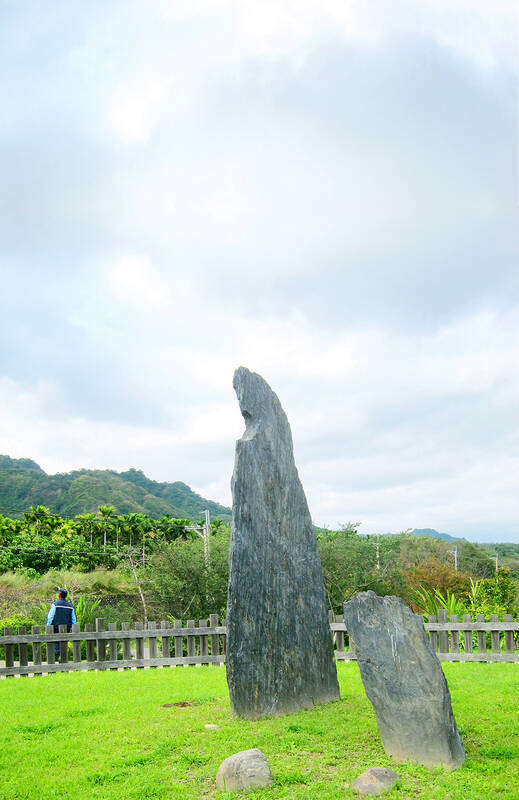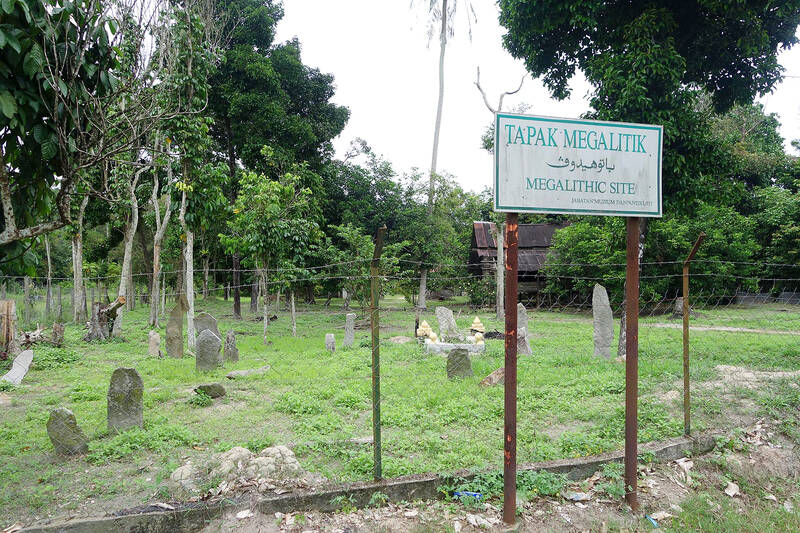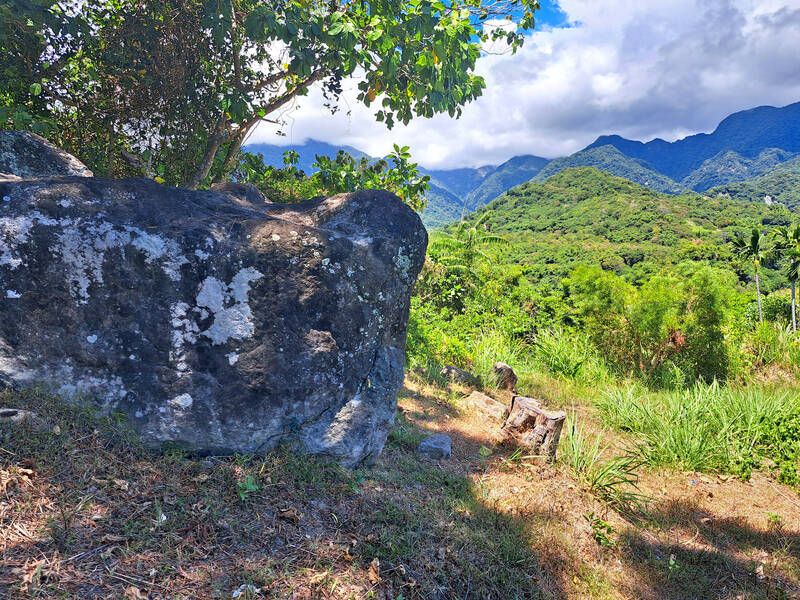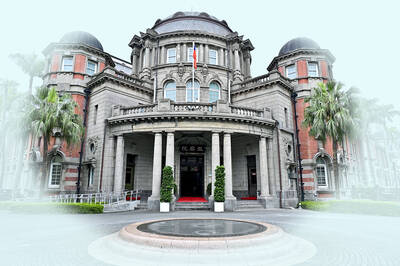Last week my friend and I hiked to a megalithic site just north of Chenggong (成功) in Taitung County, the Baishoulian stone coffin (白守蓮岩棺). You can drive almost to the stone, but it’s best to walk the last 300 meters or so of the unpaved access road if you are in a vehicle low on power with poor tires, as we were.
The coffin lies on a shelf below the foothills of the coastal range, with excellent views out to the ocean and the island of Sansiantai (三仙台) and its iconic arched bridge. My friend explained that according to local Amis lore, hunters used to rest at the site. It was a brilliant day, the kind of loveliness that makes you forget, until you look at the cracked earth and drooping crops, that Taitung is short on rainfall and its rivers are mere trickles.
The shelves a few meters up on the east coast house many such relics and archaeological sites. The east coast is one of the most rapidly rising locations in the world, with tectonic uplift raising it from five up to 13 meters every thousand years or so, according to one expert text. Hence, in ancient times, the terraces archaeologists now explore were much lower.

Photo courtesy of Wikimedia Commons
On the way to the massive carved stone we spotted a pile of rocks under a tree and went over to inspect them. Lying across a pile of smaller rocks was a dull gray slab over a meter long, an ideal candidate for a former standing stone, with a large notch on one side of the narrow end, a common feature of local megaliths. One of the rocks around it had a couple of holes drilled in it. “We are relics!” they seemed to be saying.
I pondered, for the umpteenth time, how many such rocks there must be around Taiwan, lost megalithic sites, stones broken and scattered by time and by settlers who used them to make walls and paving stones. I also reflected on how little-known Taiwan’s megaliths are, and what a wonderful themed tourist experience they might make, if they were better positioned by the island’s tourism authorities.
SWATH OF STONES

Photo: Michael Turton
We started to explore the hillside above the rock to see what other relics might be in evidence, but my friend warned me that the hillsides in such remote areas are often heavily trapped by local hunters. The trappers use steel traps with jaws that close on the legs of their victims. “It’s why so many dogs around here have three legs,” he observed dolefully.
In a swath beginning in Fangliao Township (枋寮) in Pingtung County and continuing around the Hengchun peninsula and north along the coast to Hualien County, there are roughly 60 known sites housing megaliths. They are largely an east coast phenomenon, as the west coast megaliths, if they ever existed in great numbers, were destroyed by settlers. Still, the odd standing stone may be found in out of the way places in the mountains on the west side, and stone sarcophagi are known from sites in and around Puli Township (埔里), among others.
The Austronesian peoples who erected them in Taiwan apparently took their megalith building culture with them when they spread across the Pacific. I once spent an absorbing day visiting megalithic sites raised by their descendants northeast of Kuala Lumpur. Malaysia alone hosts hundreds of such sites.

Photo: Michael Turton
The megaliths were brought to scientific attention by the Japanese, who initiated modern anthropological and archaeological work on the island of Taiwan. Ryuzo Torii, the famed Japanese anthropologist and ethnologist, photographed the megaliths at what is now the Beinan (卑南) site in Taitung during a visit to Taiwan in 1897, pioneering the use of cameras in anthropology and inspiring later field workers to employ photographic techniques. Torii’s last paper, published in 1926, was the first paper on megaliths in Taiwan, linking them to their counterparts in Indonesia and Malaysia.
TWO BROAD TYPES
In Taiwan, a recent review paper by Chao Chin-yung (趙金勇) and Chung Kuo-feng (鍾國風) titled “Megaliths in Eastern Taiwan Reconsidered” state that megalith types include “sarcophagi (岩棺),” menhirs or upright stones (單石), wall or shaped slabs (石壁), statues, stone discs, or “money” (石輪/有孔石盤), large or small columns (石柱) and perhaps “steps (石梯).” The famous slate coffins found in southeastern Taiwan were once considered a megalithic form but are no longer classified as megaliths.
Chao and Chung group the megaliths on the east coast into two very broad types. One group is found at neolithic sites along the coast with dates ranging from 3,200 to 2,500 years ago (BP), while the second is scattered around the Rift Valley and occurs somewhat later, around 2,800 BP, and lasted through the neolithic, perhaps into the early metal age around 1,500 BP.
Among these, the most common type of megalith is the menhir, or standing stone, seldom over 1.5m tall. Detailed work classifies them into many types, but the most representative type of menhir is the shouldered stone in which one or both sides of the top have been notched, removed or otherwise worked.
In some places, such as Fushih (富士) and Fuyuan (富源) in Hualien, menhirs are found in postholes, indicating they were part of a structure. At Fushih they were clearly worked by metal tools. The Fuyuan site houses a large number of megaliths, with over 100 known above ground scattered across a slope and more unearthed in recent excavations.
A PhD thesis on Fuyuan by Yao Shu-yuh (姚書宇) of National Taiwan University notes that the site was largely undisturbed because of its remoteness. There are two cultural layers, one Neolithic and one from the Iron Age. Work there uncovered numerous artifacts, including potsherds and jade tools, stone walled houses, and large, donut-shaped stones, the “money” stones resembling smaller versions of the famed rai of the Yap islanders.
SILENT STONES
The full inventiveness of Taiwan’s ancient people is not much appreciated outside archaeological circles.
After we had inspected the megalith, we ambled back to our vehicles and drove over to an archaeological site near Chenggong, where work is apparently ongoing, in the fits and spurts that time and funding and research interest permit. The location is ideal for early human habitation, a group of natural rock shelters hollowed by water into the face of what had once been a low rock bluff next to the ocean but is now a terrace. Under the shelters my friend spotted an underground creek.
The site is separated from the road by an irrigation ditch lined by an old wall first put in by the Japanese. The grounds are strewn with rocks, many tossed there by road workers or the local farmers, but there are several massive stones too large for anything but powered equipment or gangs of workers to move easily.
I clambered over the pile of stones, looking for signs that they had been worked.
But the stones were silent.
Notes from Central Taiwan is a column written by long-term resident Michael Turton, who provides incisive commentary informed by three decades of living in and writing about his adoptive country. The views expressed here are his own.

That US assistance was a model for Taiwan’s spectacular development success was early recognized by policymakers and analysts. In a report to the US Congress for the fiscal year 1962, former President John F. Kennedy noted Taiwan’s “rapid economic growth,” was “producing a substantial net gain in living.” Kennedy had a stake in Taiwan’s achievements and the US’ official development assistance (ODA) in general: In September 1961, his entreaty to make the 1960s a “decade of development,” and an accompanying proposal for dedicated legislation to this end, had been formalized by congressional passage of the Foreign Assistance Act. Two

Despite the intense sunshine, we were hardly breaking a sweat as we cruised along the flat, dedicated bike lane, well protected from the heat by a canopy of trees. The electric assist on the bikes likely made a difference, too. Far removed from the bustle and noise of the Taichung traffic, we admired the serene rural scenery, making our way over rivers, alongside rice paddies and through pear orchards. Our route for the day covered two bike paths that connect in Fengyuan District (豐原) and are best done together. The Hou-Feng Bike Path (后豐鐵馬道) runs southward from Houli District (后里) while the

The Taipei Times last week reported that the Control Yuan said it had been “left with no choice” but to ask the Constitutional Court to rule on the constitutionality of the central government budget, which left it without a budget. Lost in the outrage over the cuts to defense and to the Constitutional Court were the cuts to the Control Yuan, whose operating budget was slashed by 96 percent. It is unable even to pay its utility bills, and in the press conference it convened on the issue, said that its department directors were paying out of pocket for gasoline

On March 13 President William Lai (賴清德) gave a national security speech noting the 20th year since the passing of China’s Anti-Secession Law (反分裂國家法) in March 2005 that laid the legal groundwork for an invasion of Taiwan. That law, and other subsequent ones, are merely political theater created by the Chinese Communist Party (CCP) to have something to point to so they can claim “we have to do it, it is the law.” The president’s speech was somber and said: “By its actions, China already satisfies the definition of a ‘foreign hostile force’ as provided in the Anti-Infiltration Act, which unlike